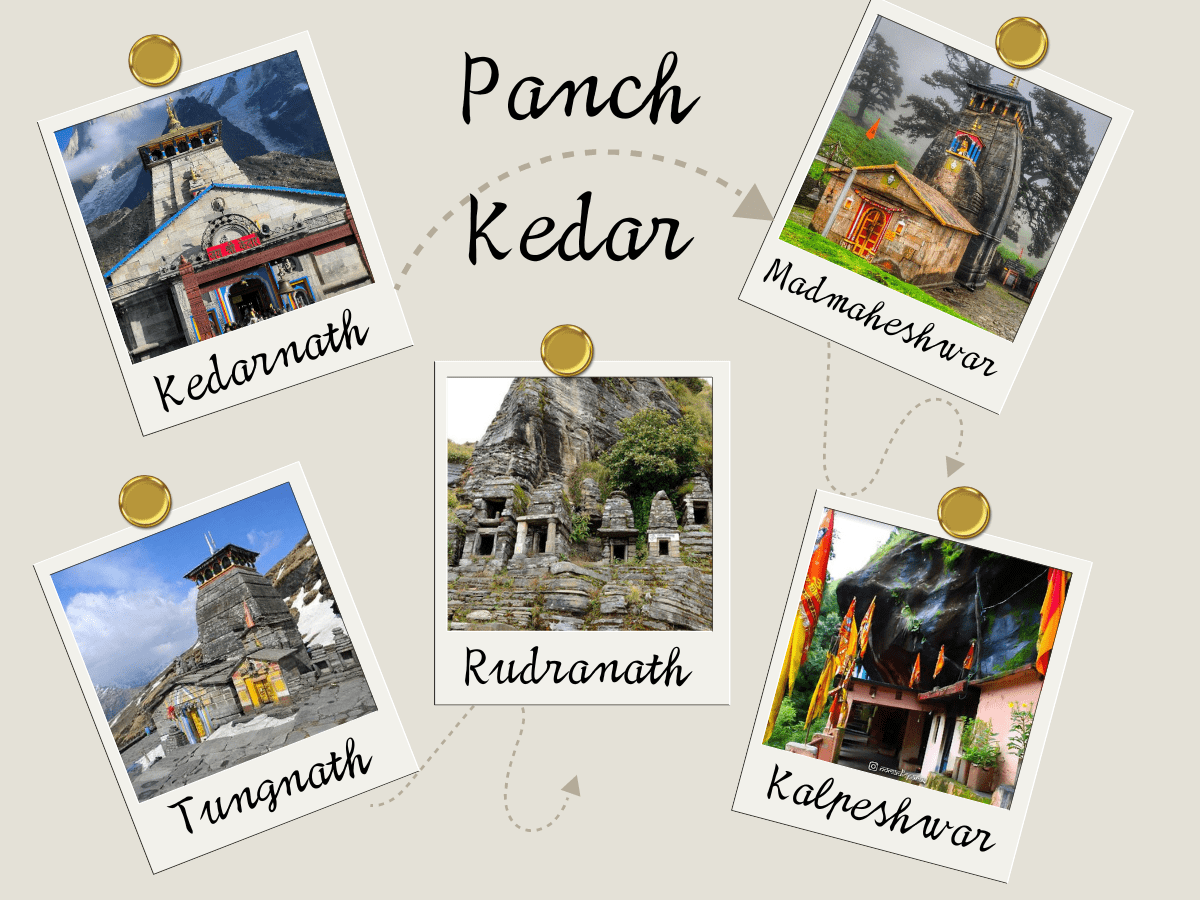The majestic Himalayas are not only a marvel of nature but also a divine sanctuary where spirituality transcends physical boundaries. Among the numerous sacred sites dotting the mountains, the Panch Kedar holds a unique and revered place in Hinduism. Comprising five ancient Shiva temples nestled in the Garhwal Himalayas of Uttarakhand, Panch Kedar is a pilgrimage that embodies devotion, endurance, and the mystic charm of nature.
The five temples that make up Panch Kedar are Kedarnath, Tungnath, Rudranath, Madhyamaheshwar, and Kalpeshwar. Each temple is associated with a unique manifestation of Lord Shiva and is steeped in legends that tie back to the Mahabharata.
This blog offers a deep dive into the spiritual essence, historical significance, and mesmerizing beauty of the Panch Kedar Yatra.
Mythological Origin of Panch Kedar
The legend of Panch Kedar dates back to the times of the Mahabharata. After the Kurukshetra war, the Pandavas, feeling guilty for killing their kin, sought the blessings of Lord Shiva to absolve their sins. Shiva, however, avoided them and took the form of a bull (Nandi) to elude them. The Pandavas pursued him, and as the bull vanished into the ground, its body parts appeared at five different places in the Garhwal region.
The hump appeared at Kedarnath
The arms at Tungnath
The face at Rudranath
The navel at Madhyamaheshwar
The hair at Kalpeshwar
The Pandavas built temples at each of these sites, collectively known as Panch Kedar, to honor Lord Shiva.
1. Kedarnath: The Most Revered Shrine
Elevation: 3,583 meters
Best Time to Visit: May to October
Situated in the Rudraprayag district, Kedarnath is the most prominent and visited temple among the Panch Kedar. The temple is built from massive stone slabs and stands against the backdrop of the Kedar Dome and Chaukhamba Peaks. The presiding deity is in the form of a pyramid-shaped lingam that represents the hump of Lord Shiva.
Kedarnath is also one of the Char Dhams of Uttarakhand and can be reached via a 16-km trek from Gaurikund. Despite the difficult terrain, millions of devotees undertake this journey every year, drawn by an unshakeable faith.
2. Tungnath: The Highest Shiva Temple
Elevation: 3,680 meters
Best Time to Visit: May to November
Tungnath holds the distinction of being the highest Shiva temple in the world. Located in the Rudraprayag district, it marks the site where Lord Shiva’s arms are believed to have emerged. The temple is more than 1,000 years old and is built in the North Indian style of architecture.
The trek to Tungnath begins from Chopta, a scenic hamlet often referred to as the Mini Switzerland of India. The 3.5 km trek to the temple is short but steep, offering spectacular views of Nanda Devi, Trishul, and Chaukhamba peaks. Just a kilometer ahead lies Chandrashila Peak, a popular trekking destination.
3. Rudranath: The Face of Shiva
Elevation: 3,600 meters
Best Time to Visit: May to October
Set amidst rhododendron forests and alpine meadows, Rudranath is the place where Lord Shiva’s face appeared. The natural rock temple is set in a mystical setting with peaks like Nanda Devi, Trishul, and Nanda Ghunti standing sentinel.
Unlike Kedarnath and Tungnath, reaching Rudranath requires a more strenuous effort. Multiple trekking routes exist, the most popular one starting from Sagar Village near Gopeshwar. The 20 km trek takes pilgrims through untouched wilderness, making the journey as soul-stirring as the destination.
Rudranath also houses several kunds (ponds) like Surya Kund, Chandra Kund, Tara Kund, and Manas Kund, adding to the sacred atmosphere.
4. Madhyamaheshwar: The Navel of the Lord
Elevation: 3,289 meters
Best Time to Visit: May to October
Madhyamaheshwar, also in the Rudraprayag district, is where the navel of Shiva is worshipped. The temple stands in a lush green valley surrounded by snow-capped peaks like Kedarnath, Neelkanth, and Chaukhamba.
The base for the Madhyamaheshwar trek is Uniana, from where it’s a 19 km hike through the picturesque villages of Ransi and Bantoli. The temple architecture is typical of the Garhwal region, and a small shrine dedicated to Parvati is located beside the main temple.
A few kilometers above the temple lies Budha Madhyamaheshwar, a vantage point offering panoramic views and considered a sacred meditation spot.
5. Kalpeshwar: The Eternal Shrine
Elevation: 2,200 meters
Best Time to Visit: Year-round
Kalpeshwar is the only Panch Kedar temple that remains open throughout the year. It is located in the Urgam Valley in the Chamoli district. Here, devotees worship Shiva’s hair (jata).
Unlike the other Panch Kedar temples, Kalpeshwar is relatively easier to access. A short trek from Helang Village (on the Badrinath highway) leads to Urgam Valley, from where it’s a 3 km trek to the temple.
Surrounded by apple orchards, terraced fields, and coniferous forests, Kalpeshwar offers a peaceful and spiritually uplifting atmosphere.
Spiritual and Natural Harmony
Each of the Panch Kedar temples represents more than just a part of Shiva’s form; they symbolize the interplay of faith, mythology, and nature. Pilgrims not only traverse physical distances but also undertake an inner journey of reflection and devotion.
These sacred shrines are all located in regions of astounding natural beauty. Alpine meadows, glacial rivers, and majestic peaks form the backdrop to an ancient spiritual tradition that continues to thrive.
The Yatra Experience
1. Sequence of Visit
Traditionally, the Panch Kedar temples are visited in the following order:
Kedarnath
Tungnath
Rudranath
Madhyamaheshwar
Kalpeshwar
Pilgrims often complete the circuit over several days or weeks, depending on the routes and physical endurance. While Kedarnath and Tungnath attract the highest number of visitors, the other three temples offer a more serene and secluded experience.
2. Trekking and Challenges
Undertaking the Panch Kedar Yatra requires physical stamina and mental resolve. Treks vary in difficulty, from easy walks to challenging ascents over rugged terrain. Proper acclimatization, fitness preparation, and guided tours are recommended for first-time trekkers.
3. Accommodation and Facilities
Most temples have basic lodges or dharamshalas nearby. In remote areas, tent accommodation and homestays are available. Pilgrims are advised to carry essentials like warm clothing, first aid, water bottles, and dry food.
Cultural and Local Significance
The villages surrounding the temples are inhabited by Garhwali communities who maintain the temples and provide services to pilgrims. Their hospitality, local cuisine, and cultural practices offer a deeper understanding of life in the Himalayas.
During the winter months, when the high-altitude temples are inaccessible, the idols are brought down to Ukhimath, Gopeshwar, and Gondar for worship. This seasonal migration of deities is a unique tradition that preserves continuity in worship.
Eco-Tourism and Responsible Travel
With growing footfall, it is crucial to practice eco-conscious tourism in the fragile Himalayan ecosystem. Pilgrims and trekkers are encouraged to:
Avoid littering and use reusable containers.
Respect local traditions and religious sentiments.
Use local guides and support village economies.
Travel in small groups to reduce environmental impact.
Best Time for Panch Kedar Yatra
The ideal time to embark on the yatra is from May to October, after the snow melts and before winter sets in. The monsoon months (July-August) can bring landslides and slippery trails, so caution is advised.
Kalpeshwar is accessible year-round, making it a good option for off-season spiritual retreats.
Conclusion: A Pilgrimage Like No Other
The Panch Kedar Yatra is not merely a journey across high-altitude terrains; it is a journey into the spiritual core of the Himalayas. Every step taken on the winding paths to these sacred shrines brings one closer to the essence of devotion, humility, and connection with the divine.
For seekers, trekkers, and lovers of mysticism, Panch Kedar offers an experience that lingers long after the journey ends. The serene chants, the crisp mountain air, the humble temple bells, and the raw beauty of nature come together to create a spiritual symphony that stays etched in the soul forever.
So, lace up your boots, pack your faith, and set out on one of the most profound pilgrimages in India — the Panch Kedar awaits.

